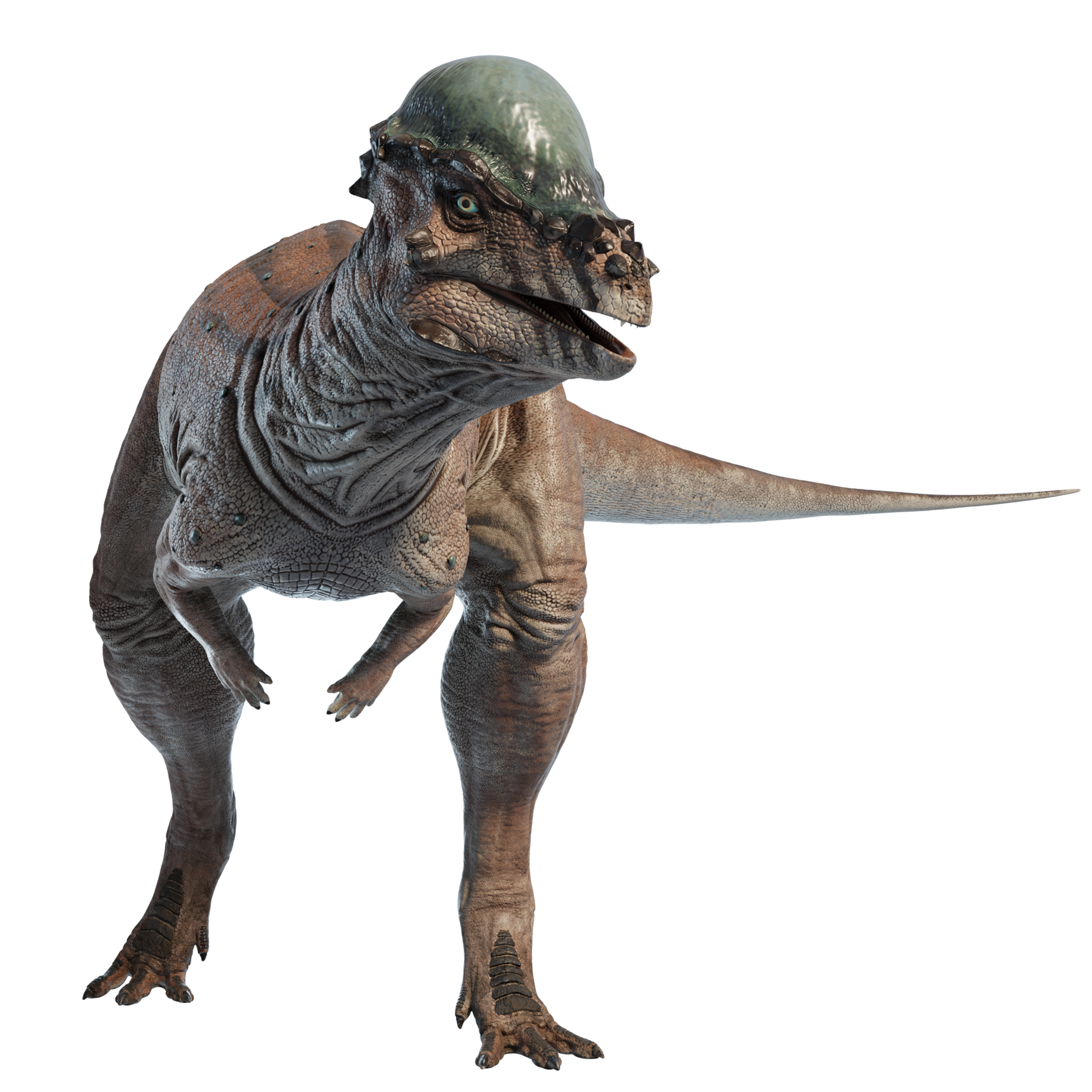The Battering Ram of Hell Creek
One of the last and largest of the pachycephalosaurs, Pachycephalosaurus, like big-horned sheep, used its thickened skull to head-butt rivals in fights over dominance and mating rights.
Overview: One of the last of largest of the pachycephalosaurs was Pachycephalosaurus, discovered in the early 20th Century and hailing from the Hell Creek and Lance Formations of Montana, South Dakota, Alberta, and Wyoming where it lived in the shadow of T-rex. Like other pachycephalosaurs, the top of its skull was hyper-thickened and dome-like, and like modern big-horned sheep or musk oxen, Pachycephalosaurus probably used its thickened skull to head-butt rivals in fights over dominance and mating rights.
Discovery: The first bone fragment (a squamosal bone from the back of the skull) of a Pachycephalosaurus was discovered in the Late Cretaceous Lance Formation of Wyoming sometime in the 1850s and named by Joseph Leidy in 1872. He called the bone Tylosteus, and thought it belonged to an armadillo-like creature. The bone wasn’t revealed to be from a Pachycephalosaurus until 1979. The holotype (original, name bearing specimen) of Pachycephalosaurus (a partial skull) was named in 1931 by Charles W. Gilmore. He called it Troodon wyomingensis, in reference to Wyoming where it was found, and because he thought, due to similarities between Pachycephalosaurus and Troodon teeth that the bones were from a Troodon. Based on more complete material from the Hell Creek Formation of Montana and the Lance Formation of South Dakota, the genus Pachycephalosaurus was named by Barnum Brown and Erich Maren Schlaikjer, a Greek name meaning “Thick Skulled Lizard”. The species name wyomingensis took priority since it was named first, and thus we got Pachycephalosaurus wyomingensis. Technically the name Tylosteus was named much earlier, but due to its incomplete nature, the uncertainty of when and where it was collected, and that it hadn’t been used in a publication in over 50 years, it was ruled that Pachycephalosaurus should take precedence. Additional material has been found in Alberta, demonstrating that Pachycephalosaurus had a wider range than previous pachycephalosaurs like Stegoceras.
Evolution: Pachycephalosaurus was a pachycephalosaur, a dome-headed, bipedal, herbivore. It was one of the most derived (“advanced”) pachycephalosaurus and lived at the tail-end of the Age of Dinosaurs, 70-66 million years ago. Pachycephalosaurs were members of the clade Marginocephalia, which also includes ceratopsians, making Pachycepalosaurus a distant cousin of the likes of Triceratops with which it shared its habitat.
Description: Pachycephalosaurus was large for a pachycephalosaur and was in fact one of if not the largest of all the pachycephalosaurs, measuring 4.5 meters (14.8 ft) long and weighing 370–450 kg (820–990 lbs). Its most notable feature was its skull dome, which could be 25 cm (10 in) thick! The back of the dome was edged by a squamosal “shelf” covered in bony knobs and short spikes. It also had a patch of short boney spikes on its snout. Its snout was short and triangular and ended in a small blunt beak. The dome grew thicker as the animal grew from hatchling to adult, and the fellow pachycephalosaurs Dracorex and Stygimoloch are probably growth stages of Pachycephalosaurus, with the classic Pachycephalosaurus being the adult stage. Like its relatives, it had leaf shaped teeth with strong serrations which resembled the teeth of Troodon. Its tail would have been held stiff by ossified tendons.
Behavior and Ecology: Pachycephalosaurus lived in the Lance and Hell Creek Formations where were warm, wet lowland environments with abundant conifers and angiosperms (flowering plants). It probably ate soft plants like leaves and fruits which it sliced up with its distinctive teeth. However, its front teeth suggest that it may have occasionally eaten meat, which would make it more of an omnivore than a strict herbivore. Still, plants probably made up the vast majority of its diet. It was a medium-sized herbivore, living in the shadows of the much larger hadrosaur Edmontosaurus, the large ceratopsid Triceratops, and the ankylosaurs Edmontonia and Ankylosaurus. It was similar in size to the medium sized ornithopod Thescelosaurus and the ornithomimid theropods Ornithomimus and Struthiomimus, which were also herbivorous. The top predator of this environment was Tyrannosaurus rex. However, adult T-rex probably preferred to hunt larger prey like Edmontosaurus and Triceratops. Juvenile T-rex on the other hand may have posed more of an active threat to Pachycephalosaurus. Troodontids and the dromaeosaur Acheroraptor may have hunted young Pachycephalosaurus but probably weren’t large enough to regularly go after the adults. And then there was Dakotaraptor a very large dromaeosaur almost 20 ft long. Adult Pachcephalosaurus and Thescelosaurs may have been some of its preferred prey.
Pachycephalosaurus likely dealt with predators by running away, but a Pachycephalosaurus guarding its nest or offspring may have used its head as a battering ram against some of these predators. However, their dome skulls were probably most often used on each other. Pachycephalosaurus may have had a social structure similar to modern big horned sheep or musk oxen, where males head-butt each other in battles for dominance and over access to females during the breeding season. As juveniles did not fight for dominance, juveniles had smaller flatter domes which grew thicker and more domed as they reached adulthood. Skull thickness and thickness of the nasal boss (a thickening of bones on the nose) may have also varied between males and females with the more combative males having the more robust skulls, which makes sense give their assumed lifestyle and social structure.
Extinction and Legacy: 66 million years ago, an asteroid twice the size of Mt. Everest smashed into the edge of the Gulf of Mexico, causing the Cretaceous-Paleogene (K-Pg) Extinction which resulted in at least 75% of all species vanishing in a geologic instant. Most famous of the casualties were the non-avian dinosaurs, including Pachycephalosaurus. Likely unable to find cover, most if not all Pachycephalosaurus probably perished in a catastrophic firestorm that cooked them where they stood just minutes after impact. If any did somehow survive the initial destruction, they would have quickly starved to death as the heat of the impact and the ejected material falling back to earth also ignited forests and left the world, and especially North America where Pachycephalosaurus lived, a scorched wasteland. Today Pachycephalosaurus can be found in museums including the National Museum of National History in Washington DC, USA, the American Museum of Natural History in New York City, New York, USA, the Museum of the Rockies in Bozeman, Montana, and the Royal Ontario Museum in Toronto, Ontario, Canada. Pachycephalosaurus and its probable juvenile form have been featured in numerous movies and television shows including several times in the Jurassic Park Franchise, a background role in Disney’s Dinosaur (2000), and a starring role in a sequence in the third episode of BBC’s Prehistoric Planet 2 (2023).
Pachycephalosaurus FAQ
Pachycephalosaurus size / How big was Pachycephalosaurus?
See height, weight, and length.
Pachycephalosaurus height / How tall was Pachycephalosaurus?
Pachycephalosaurus was probably about 1.55 meters (5.1 ft) tall.
Pachycephalosaurus weight / How much did Pachycephalosaurus weigh?
Pachycephalosaurus weighed about 370–450 kg (820–990 lbs).
How long was Pachycephalosaurus?
Pachycephalosaurus was about 4.5 meters (14.8 ft) long.
What did Pachycephalosaurus eat?
Pachycephalosaurus ate soft plants, perhaps including fruit, as well as possibly insects and occasional meat, making it a potential omnivore, though it was mostly herbivorous.
What is Pachycephalosaurus closest living relative?
Like all dinosaurs, the closest relatives of Pachycephalosaurus are the only surviving lineage of dinosaurs today, the birds. Crocodilians, while not dinosaurs themselves, are also more distant cousins of dinosaurs.
Pachycephalosaurus family members / Pachycephalosaurus family / What kind of dinosaur was Pachycephalosaurus?
Pachycephalosaurus was an ornithischian (“bird-hipped dinosaur”) in the family Pachycephalosauridae. Pachycephalosauridae belonged to the larger clade Pachycephalosauria (dome-headed dinosaurs), which in turn belonged to Marginocephalia which also contains the ceratopsians.
Where did Pachycephalosaurus live? / Where was Pachycephalosaurus found?
Pachycephalosaurus lived in Laramidia (western North America) and has been found in Wyoming, Montana, South Dakota, Alberta.
When did Pachycephalosaurus live?
Pachycephalosaurus lived about 70-66 million years ago at the end of the Cretaceous Period.
What does Pachycephalosaurus mean? / Pachycephalosaurus name meaning
Pachycephalosaurus means “Thick Skulled Lizard”.
Did Pachycephalosaurus butt heads?
Yes, pathologies on fossils of pachycephalosaur domes suggests that they did indeed headbutt each other.

